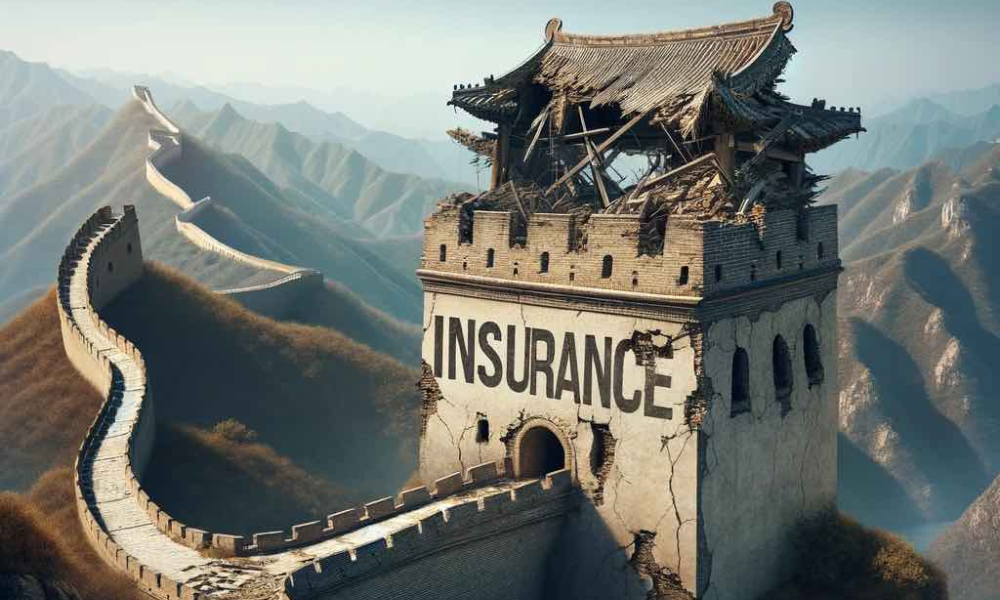China’s major insurance problem

Nearly eight years have passed since China initiated an extensive campaign to curb the aggressive tactics employed by its insurance sector, yet the battle to reign in cowboy behaviour remains unfinished. Estimates suggest that problematic assets amount to one trillion yuan (over $140 billion), highlighting the ongoing struggle against financial instability.
This government initiative primarily targeted insurers linked with private conglomerates, which used their extensive finance sector connections to embark on high-risk growth strategies.
Notably, the campaign has seen the collapse of industry behemoths such as Anbang Insurance Group Co. Ltd.(which made worldwide headlines when it paid $1.95 billion for New York’s Waldorf Astoria) and Tomorrow Holding Co. Ltd.
The insurance sector, which accounts for over 23% of China’s GDP and stands as the second-largest globally, had amassed total assets of 29.6 trillion yuan by September 2023, as per the National Administration of Financial Regulation (NAFR). One significant development in the sector’s attempt to stabilize was the acquisition of bankrupt Tomorrow Holding’s E An Property & Casualty Insurance Co. Ltd. by electric vehicle powerhouse BYD Co. in May 2023 for $1 million. This move marked the conclusion of a three-year bankruptcy reorganization, representing the nation’s inaugural successful rehabilitation of a bankrupt insurer.
E An’s financial woes, primarily stemming from embezzlement by major shareholders, symbolize the broader challenges faced by the industry. Despite efforts to salvage companies like E An, the insurance landscape continues to deteriorate, exacerbated by the pandemic’s lingering effects, poor investment outcomes, and low-interest rates. These factors have raised alarms over insurers’ abilities to honour maturing policies.
NAFR data reveals that the risk-laden insurance assets have ballooned beyond 600 billion yuan ($83.4 billion), with some estimates reaching 1 trillion yuan. The total assets of China’s insurance sector were recorded at 29.96 trillion yuan by the end of 2023, with a mere 2.73 trillion yuan in net assets, indicating a high debt ratio. A troubling rise in the number of insurance companies rated as high-risk underscores the severity of the situation, with those failing to meet solvency ratios climbing significantly.
China has roughly 200 licensed insurance companies, and the number of those rated C or D more than quadrupled from the six there were in the third quarter of 2020, to 27 in the first quarter of last year.
China’s crackdown on financial risk, initiated in 2017, targeted the insurance industry’s reckless elements, leading to regulatory actions against risky products and corrupt practices. The current strategies for addressing the risks involve leveraging both industry and external resources, as well as postponing risk resolution to allow for strategic flexibility. However, these measures have been met with skepticism amid changing market conditions and regulatory delays, which have led to asset devaluation and increased financial losses within the sector.
In 2022, the profit of China’s 86 life insurance companies dropped by 57.3% to 57.2 billion yuan ($8.5 billion).
Only 38 of these companies were profitable, a decrease from 59 profitable companies the previous year.
A total of 71 life insurance companies performed worse than the year before.
The top 10 loss-making life insurers accounted for a combined loss of 109.7 billion yuan.
Despite the decline in life insurance company profits, the overall insurance industry in China saw a 4.6% increase in premium income to 4.7 trillion yuan in 2022.
This increase in premium income comes after a 0.8% decline in 2021, and follows growth rates of 6.1% in 2020 and 12.2% in 2019.
The average investment return for the insurance industry in 2022, excluding unrealized gains and losses, was 3.76%.
In the first half of the following year, life insurers were instructed to lower the assumed rates of return on new products to below 3.5% for traditional products, 2.5% for participating policies, and 2% for universal life products to relieve balance sheet pressure.
The insurance industry’s premium income saw a growth of 9.13% in 2023, yet the industry is grappling with investment return rates hitting their lowest since 2006. The economic downturn and weakening performance of insurers signal tougher challenges ahead in risk mitigation efforts. Insights from industry experts, such as Zhou Guorui in-house counsel of Taikang Life Insurance, have highlighted the need for precise actions to address the integrity of major shareholders and improve management professionalism.
As part of its risk management strategy, China has focused on stabilizing smaller financial institutions and improving regulatory frameworks. The process involves transferring viable assets to new entities to attract investment while managing troubled assets separately. The role of industry leaders and government-backed investors has been pivotal, with significant funds allocated to support high-risk insurance firms.
The case of E An, which emerged from financial turmoil following its acquisition by BYD, illustrates the potential for recovery through judicial and market-oriented measures. However, addressing the larger financial voids left by entities like Tomorrow Holding and Anbang will require continued effort from authorities along with substantial capital injections. The challenge of balancing risk mitigation with financial stability remains daunting, necessitating a careful approach to management and regulatory oversight to prevent further industry destabilization.
Which are China’s biggest insurers?
General insurers by written premium:
The People’s Insurance Company (Group) of China Ltd: $69,706 million
Ping An Insurance (Group) Company of China Ltd: $45,044 million
Life insurers by written premium:
China Life Insurance Co Ltd: $96,108 million
Ping An Insurance (Group) Company of China Ltd: $76,026 million
China Pacific Insurance (Group) Co Ltd: $32,578 million





